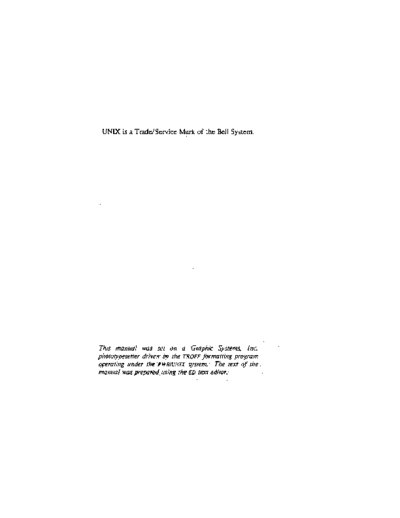Service Manuals, User Guides, Schematic Diagrams or docs for : AT&T unix PWB_UNIX PWB_UNIX_Edition_1_Section_1_May77
<< Back | HomeMost service manuals and schematics are PDF files, so You will need Adobre Acrobat Reader to view : Acrobat Download Some of the files are DjVu format. Readers and resources available here : DjVu Resources
For the compressed files, most common are zip and rar. Please, extract files with Your favorite compression software ( WinZip, WinRAR ... ) before viewing. If a document has multiple parts, You should download all, before extracting.
Good luck. Repair on Your own risk. Make sure You know what You are doing.
Image preview - the first page of the document

>> Download PWB_UNIX_Edition_1_Section_1_May77 documenatation <<
Text preview - extract from the document
UNIX is a Trade/Service Mark of the Bell System.
This manual was set on a Graphic Systems, Inc.
C
phototypesetter driven' by the'TROFF formatting 'program
Qperating under the 'PWB/UNIX system. The text of the
manual was prepared using the Ef) rexteditor.
ACKNOWLEDGEMENTS
The form and organization of this manual, as well as a major fraction of its contents, have been
copied from the UNIX Programmer's Manual-Sixth Edition, by K. Thompson and D. M. Ritchie
(Bell Telephone Laboratories, May 1975). The number of our colleagues who have contributed
to UNIX and PWB/UNIX software and documentation is, by now, too large to list here, but the use-
fulness and acceptance of UNIX and of PWB/UNIX is a true measure of their collective success.
Piscataway, New Jersey T.A.D.
May 1977 R.C.H.
E.M.P.
- iii -
INTRODUCTION
This manual describes the features of PWB/UNIX. It provides neither a general overview of UNIX
(for that, see "The UNIX Time-Sharing System," Comm. ACM 17(7):365-75, July 1974, by
D. M. Ritchie and K. Thompson), nor details of the implementation of the system.
This manual is divided into eight sections:
I. Commands and Application Programs
II. System Calls
III. Subroutines
IV. Special Files
V. File Formats and Conventions
VI. Games
VII. Miscellaneous
VIII. System Maintenance
Section I (Commands and Application Programs) describes programs intended to be invoked
directly by the user or by command language procedures, in contradistinction to subroutines,
which are intended to be called by the user's programs. Commands generally reside in the
directory Ibin (for binary programs). Some programs also reside in lusr/bin, to save space in Ibin.
These directories are searched automatically by the command interpreter called the Shell.
Section II (System Calls) describes the entries into the UNIX supervisor, including the assembler
and the C language interfaces. In the assembler, these system calls are invoked by the sys
operation code, which is a synonym for the trap instruction.
Section III (Subroutines) describes the available subroutines. Their binary versions reside in
various system libraries in directory /lib. The subroutines available for C and for Fortran are
also included there~ they reside in Ilibllibc.a and llibllibj.a, respectively.
Section IV (Special Files) discusses the characteristics of each system "file" that actually refers
to an inputloutput device. The names in that section refer to the Digital Equipment
Corporation's device names for the hardware, instead of the names of the special files them-
selves.
Section V (File Formats and Conventions) documents the structure of particular kinds of files~
for example, the form of the output of the assembler and the loader is given. Excluded are
files used by only one command, for example, the assembler's intermediate files.
Section VIII (System Maintenance) discusses commands that are not intended for use by the
ordinary user, in some cases because they disclose information in which he or she is presum-
ably not interested, and in others because they perform privileged functions.
Each section consists of a number of independent entries of a page or so each. The name of
the entry is in the upper corners of its pages. Entries within each section are alphabetized. The
page numbers of each entry start at 1.
All entries are based on a common format, not all of whose parts always appear:
The NAME part repeats the name of the entry and states (very briefly) its purpose.
The SYNOPSIS part summarizes the use of the program being described. A few conven-
tions are used, particularly in Section I (Commands):
Boldface strings are considered literals, and are to be typed just as they appear
(they are usually underlined in the typed version of the manual entries unless
they are juxtaposed with an italic string).
-v-
Italic strings usually represent substitutable arguments (they are underlined in
the typed version of the manual entries).
Square brackets around an argument indicate that the argument is
H [ ]"
optional. When an argument is given as ~~name'" or ~~file", it always refers to a
file name.
Ellipses H ◦ Jabse Service Manual Search 2024 ◦ Jabse Pravopis ◦ onTap.bg ◦ Other service manual resources online : Fixya ◦ eServiceinfo